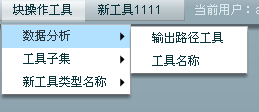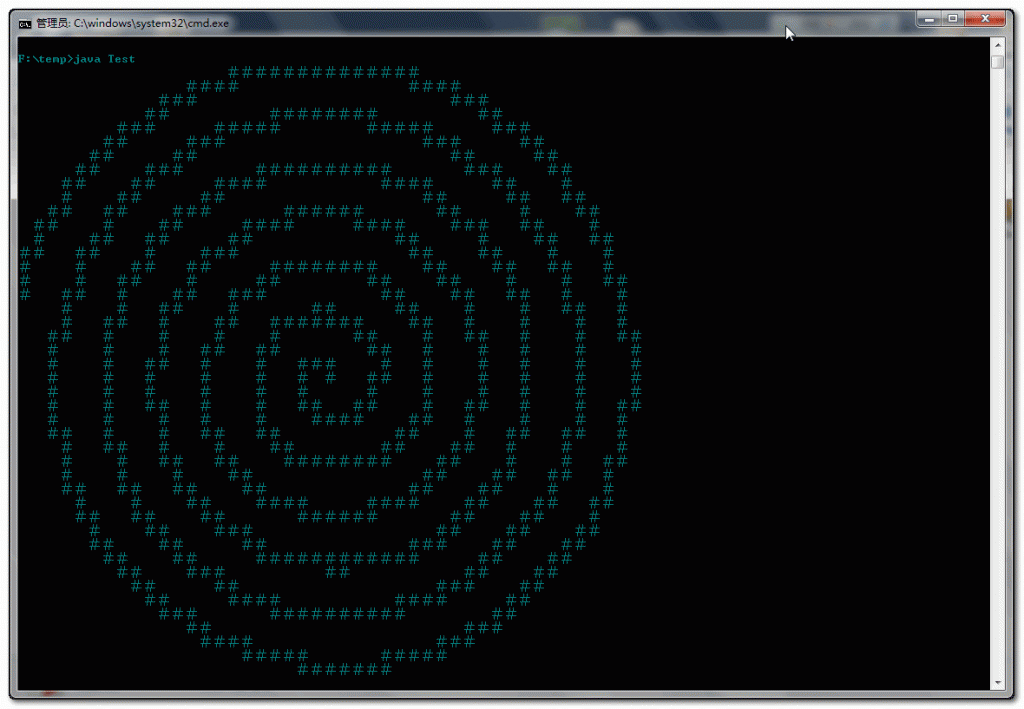java面试题-----------你觉得这段代码输出的是什么?
Java --------------------编程问答-------------------- Father
public class test05 {
public static void main(String[] args) {
Father f = new Child();
System.out.println(f.x);
}
}
class Father {
int x = 10;
public Father() {
add(20);
}
public void add(int y) {
System.out.println("Father");
x += y;
}
}
class Child extends Father {
int x = 9;
public void add(int y) {
System.out.println("Child");
x += y;
System.out.println(x + ": :" + y);
}
}
9 --------------------编程问答--------------------
这题变着法儿的考啊,还不如直接问复杂对象的构造过程!
Child
20: :20
10
--------------------编程问答-------------------- 求解释啊。。。看不明白 --------------------编程问答--------------------
======================================
说得这么简单,不运行的时候,你不一定就能做出来。
我学识太浅,我做错了,我以为结果会为29 : :20
29
执行构造方法时,Child的构造方法之前执行add方法,
而我以前一直认为子类的变量和代码块执行在父类构造方法之前,这一点我错了。
既然add方法时,并没有初始化子父变量,那么x应该是父类的变量,
结果已经应该为30,子父变量为9未初始化,如果初始化了,那么应该为29。
可执行完成后,子父的变量X=9保持不变,父类的变量X=10不变,那么执行add方法的X变量值到哪里去了?
等忙完手头的事情,JVM还是要更多的关注一下。 --------------------编程问答-------------------- 还有,楼主不要纠结这些问题,类的构造顺序要弄清楚,静态变量-》静态代码-》MINA-》成员变量-》代码块-》构造方法。
向那些特别复杂的,得深入了解JVM才能理解。慢慢成长吧。静态的执行父-》子。初始化的成员与构造方法,按上题执行应该是初始化父类完成再初始化子类。 --------------------编程问答-------------------- 其实这个问题我知道,只是觉得这道题比较有趣
 --------------------编程问答--------------------
--------------------编程问答--------------------
public class test05 {
public static void main(String[] args) {
Father f = new Child();
System.out.println(f.x);
}
}
class Father {
int x = 10;
public Father() {
add(20);
}
public void add(int y) {
System.out.println("Father");
x += y;
}
}
class Child extends Father {
int x = 9;
public void add(int y) {
System.out.println("Child");
x += y;
System.out.println(x + ": :" + y);
}
}
这题变着法儿的考啊,还不如直接问复杂对象的构造过程!
Child
20: :20
10
======================================
说得这么简单,不运行的时候,你不一定就能做出来。
我学识太浅,我做错了,我以为结果会为29 : :20
29
执行构造方法时,Child的构造方法之前执行add方法,
而我以前一直认为子类的变量和代码块执行在父类构造方法之前,这一点我错了。
既然add方法时,并没有初始化子父变量,那么x应该是父类的变量,
结果已经应该为30,子父变量为9未初始化,如果初始化了,那么应该为29。
可执行完成后,子父的变量X=9保持不变,父类的变量X=10不变,那么执行add方法的X变量值到哪里去了?
等忙完手头的事情,JVM还是要更多的关注一下。
 --------------------编程问答--------------------
--------------------编程问答--------------------
public class test05 {
public static void main(String[] args) {
Father f = new Child();
System.out.println(f.x);
}
}
class Father {
int x = 10;
public Father() {
add(20);
}
public void add(int y) {
System.out.println("Father");
x += y;
}
}
class Child extends Father {
int x = 9;
public void add(int y) {
System.out.println("Child");
x += y;
System.out.println(x + ": :" + y);
}
}
这题变着法儿的考啊,还不如直接问复杂对象的构造过程!
Child
20: :20
10
======================================
说得这么简单,不运行的时候,你不一定就能做出来。
我学识太浅,我做错了,我以为结果会为29 : :20
29
执行构造方法时,Child的构造方法之前执行add方法,
而我以前一直认为子类的变量和代码块执行在父类构造方法之前,这一点我错了。
既然add方法时,并没有初始化子父变量,那么x应该是父类的变量,
结果已经应该为30,子父变量为9未初始化,如果初始化了,那么应该为29。
可执行完成后,子父的变量X=9保持不变,父类的变量X=10不变,那么执行add方法的X变量值到哪里去了?
等忙完手头的事情,JVM还是要更多的关注一下。
===================================
这图表示什么意思,如果你很强,不要给出运行结果,给出代码在运行过程中的路径,包括在JVM的状态。要不然,楼主怎么明白? --------------------编程问答-------------------- 这个的确很难啊 --------------------编程问答-------------------- 跟着debug走,发现f.x方法的时候,f的x和c的x会恢复成9和10(前面构造函数的时候都变成10和20了,但是构造函数执行完,这两个值就被清空了……) --------------------编程问答-------------------- 执行顺序:f构造器,f.x = 10,后进c的add方法,由y传值20(此时c.x = 0),后f构造方法结束,进c构造方法c.x=9,到此这个
Father f = new Child();方法结束并且两个x都被清掉
在下一行输出f.x的时候,f.x=10,c.x=9……你说会输出哪个呢?
完毕…… --------------------编程问答-------------------- 感觉楼主的题目相当有意思,小弟好好的研究了一番,抛砖引玉一把。
// 原则1:属性不多态(计算机认为同名变量不相同)
// 原则2:方法多态(哪个类方法就是用哪个类属性)
public class test05 {
public static void main(String[] args) {
Father f = new Child();
// 原则1:属性不多态,可以想象一下将Father里的属性x改名为fx,那么打印f.fx肯定是10
System.out.println(f.x);
}
}
class Father {
int x = 10;
public Father() {
// 原则2:调用的是子类方法,本例因为Child的x还未赋值,默认是0。调用的结果只是改变了子类对象的变量值,不会改变父类变量值
add(20);
// 后加的语句,这个才会改变父类的变量值。
// x = 100;
}
public void add(int y) {
System.out.println("Father");
x += y;
}
}
class Child extends Father {
int x = 9;
// 原则2:本方法只会改变本类里定义的变量Child类里的x
public void add(int y) {
System.out.println("Child");
x += y;
System.out.println(x + ": :" + y);
// 后加的语句,这个才会改变父类的变量值。
// super.x = 100;
}
}
--------------------编程问答--------------------
感谢5楼的兄弟指点,不过测试发现你说的有点不准确:应该是:代码块、成员变量的优先级相同,由源代码定义的先后决定。如下代码就是代码块先执行。
public class T {
{
a = 9;
}
int a = 100;
public static void main(String[] args) {
T t = new T();
System.out.println(t.a);
}
}
--------------------编程问答--------------------
感谢5楼的兄弟指点,不过测试发现你说的有点不准确:
应该是:代码块、成员变量的优先级相同,由源代码定义的先后决定。如下代码就是代码块先执行。
public class T {
{
a = 9;
}
int a = 100;
public static void main(String[] args) {
T t = new T();
System.out.println(t.a);
}
}
==========================
老大,你这样写都无法编译通过呀。 --------------------编程问答--------------------
感谢5楼的兄弟指点,不过测试发现你说的有点不准确:
应该是:代码块、成员变量的优先级相同,由源代码定义的先后决定。如下代码就是代码块先执行。
public class T {
{
a = 9;
}
int a = 100;
public static void main(String[] args) {
T t = new T();
System.out.println(t.a);
}
}
==========================
老大,你这样写都无法编译通过呀。
我这是从eclipse里面拷出来的代码,怎么没法编译通过呢? --------------------编程问答--------------------
感谢5楼的兄弟指点,不过测试发现你说的有点不准确:
应该是:代码块、成员变量的优先级相同,由源代码定义的先后决定。如下代码就是代码块先执行。
public class T {
{
a = 9;
}
int a = 100;
public static void main(String[] args) {
T t = new T();
System.out.println(t.a);
}
}
父类静态代码块->子类静态代码块->父类构造函数->父类非静态代码块->子类构造函数->子类非静态代码块 --------------------编程问答--------------------
感谢5楼的兄弟指点,不过测试发现你说的有点不准确:
应该是:代码块、成员变量的优先级相同,由源代码定义的先后决定。如下代码就是代码块先执行。
public class T {
{
a = 9;
}
int a = 100;
public static void main(String[] args) {
T t = new T();
System.out.println(t.a);
}
}
==========================
老大,你这样写都无法编译通过呀。
我这是从eclipse里面拷出来的代码,怎么没法编译通过呢?
 --------------------编程问答--------------------
Child
--------------------编程问答--------------------
Child20: :20
10 --------------------编程问答--------------------
感谢5楼的兄弟指点,不过测试发现你说的有点不准确:
应该是:代码块、成员变量的优先级相同,由源代码定义的先后决定。如下代码就是代码块先执行。
public class T {
{
a = 9;
}
int a = 100;
public static void main(String[] args) {
T t = new T();
System.out.println(t.a);
}
}
父类静态代码块->子类静态代码块->父类构造函数->父类非静态代码块->子类构造函数->子类非静态代码块
非静态代码块是先于构造方法执行的,要不然构造方法怎么能起到初始化成员的作用 --------------------编程问答-------------------- 所实话 我没有看懂 --------------------编程问答-------------------- 好吧,我做错了 --------------------编程问答-------------------- 除 --------------------编程问答-------------------- 考的是类(继承情况下)的初始化顺序
代码注释中用()标识的是代码执行顺序,看一下就明白了
--------------------编程问答-------------------- 好题目啊,我又错了。。。 --------------------编程问答-------------------- 我发现自己好好脆 --------------------编程问答--------------------
public class test05 {
public static void main(String[] args) {
System.out.println("(1)");
Father f = new Child();//(1)
System.out.println("(7)");
System.out.println(f.x);//(7) Father.x = 10
}
}
class Father {
int x = 10;//(2)
{
System.out.println("(2)");
}
public Father() {
System.out.println("(3)");
add(20);//(3)
}
//子类有重载,无视之
public void add(int y) {
System.out.println("Father");
x += y;
}
}
class Child extends Father {
int x = 9;//(5),在5之前,x的值为0(还没有初始化)
{
System.out.println("(5)");
}
public Child() {
super();//(1)
//(6)
System.out.println("(6)");
}
public void add(int y) {
System.out.println("(4)");
//(4)此时Child.x = 0
System.out.println("Child");
x += y;//x = 0 + 20 = 20
System.out.println(x + ": :" + y);//20,20
}
}
考的是类(继承情况下)的初始化顺序
代码注释中用()标识的是代码执行顺序,看一下就明白了
public class test05 {
public static void main(String[] args) {
System.out.println("(1)");
Father f = new Child();//(1)
System.out.println("(7)");
System.out.println(f.x);//(7) Father.x = 10
}
}
class Father {
int x = 10;//(2)
{
System.out.println("(2)");
}
public Father() {
System.out.println("(3)");
add(20);//(3)
}
//子类有重载,无视之
public void add(int y) {
System.out.println("Father");
x += y;
}
}
class Child extends Father {
int x = 9;//(5),在5之前,x的值为0(还没有初始化)
{
System.out.println("(5)");
}
public Child() {
super();//(1)
//(6)
System.out.println("(6)");
}
public void add(int y) {
System.out.println("(4)");
//(4)此时Child.x = 0
System.out.println("Child");
x += y;//x = 0 + 20 = 20
System.out.println(x + ": :" + y);//20,20
}
}
--------------------编程问答-------------------- 明白了代码的初始化顺序!好题目! --------------------编程问答--------------------
class A{
static{
System.out.print("1");
}
public A(){
System.out.print("2");
}
}
class B extends A{
static{
System.out.print("a");
}
public B(){System.out.print("b");
}
}
public class Hello{
public static void main(String[] ars)
{
A ab = new B();
ab = new B();
}
}
那请解释一下下面的代码:
考的是类(继承情况下)的初始化顺序
代码注释中用()标识的是代码执行顺序,看一下就明白了
public class test05 {
public static void main(String[] args) {
System.out.println("(1)");
Father f = new Child();//(1)
System.out.println("(7)");
System.out.println(f.x);//(7) Father.x = 10
}
}
class Father {
int x = 10;//(2)
{
System.out.println("(2)");
}
public Father() {
System.out.println("(3)");
add(20);//(3)
}
//子类有重载,无视之
public void add(int y) {
System.out.println("Father");
x += y;
}
}
class Child extends Father {
int x = 9;//(5),在5之前,x的值为0(还没有初始化)
{
System.out.println("(5)");
}
public Child() {
super();//(1)
//(6)
System.out.println("(6)");
}
public void add(int y) {
System.out.println("(4)");
//(4)此时Child.x = 0
System.out.println("Child");
x += y;//x = 0 + 20 = 20
System.out.println(x + ": :" + y);//20,20
}
}
class A{
static{
System.out.print("1");
}
public A(){
System.out.print("2");
}
}
class B extends A{
static{
System.out.print("a");
}
public B(){System.out.print("b");
}
}
public class Hello{
public static void main(String[] ars)
{
A ab = new B();
ab = new B();
}
}
这个就简单了:1a2b2b --------------------编程问答--------------------
那请解释一下下面的代码:
考的是类(继承情况下)的初始化顺序
代码注释中用()标识的是代码执行顺序,看一下就明白了
public class test05 {
public static void main(String[] args) {
System.out.println("(1)");
Father f = new Child();//(1)
System.out.println("(7)");
System.out.println(f.x);//(7) Father.x = 10
}
}
class Father {
int x = 10;//(2)
{
System.out.println("(2)");
}
public Father() {
System.out.println("(3)");
add(20);//(3)
}
//子类有重载,无视之
public void add(int y) {
System.out.println("Father");
x += y;
}
}
class Child extends Father {
int x = 9;//(5),在5之前,x的值为0(还没有初始化)
{
System.out.println("(5)");
}
public Child() {
super();//(1)
//(6)
System.out.println("(6)");
}
public void add(int y) {
System.out.println("(4)");
//(4)此时Child.x = 0
System.out.println("Child");
x += y;//x = 0 + 20 = 20
System.out.println(x + ": :" + y);//20,20
}
}
class A{
static{
System.out.print("1");
}
public A(){
System.out.print("2");
}
}
class B extends A{
static{
System.out.print("a");
}
public B(){System.out.print("b");
}
}
public class Hello{
public static void main(String[] ars)
{
A ab = new B();
ab = new B();
}
}
这个就简单了:1a2b2b
运行一下看看!
那请解释一下下面的代码:
考的是类(继承情况下)的初始化顺序
代码注释中用()标识的是代码执行顺序,看一下就明白了
public class test05 {
public static void main(String[] args) {
System.out.println("(1)");
Father f = new Child();//(1)
System.out.println("(7)");
System.out.println(f.x);//(7) Father.x = 10
}
}
class Father {
int x = 10;//(2)
{
System.out.println("(2)");
}
public Father() {
System.out.println("(3)");
add(20);//(3)
}
//子类有重载,无视之
public void add(int y) {
System.out.println("Father");
x += y;
}
}
class Child extends Father {
int x = 9;//(5),在5之前,x的值为0(还没有初始化)
{
System.out.println("(5)");
}
public Child() {
super();//(1)
//(6)
System.out.println("(6)");
}
public void add(int y) {
System.out.println("(4)");
//(4)此时Child.x = 0
System.out.println("Child");
x += y;//x = 0 + 20 = 20
System.out.println(x + ": :" + y);//20,20
}
}
class A{
static{
System.out.print("1");
}
public A(){
System.out.print("2");
}
}
class B extends A{
static{
System.out.print("a");
}
public B(){System.out.print("b");
}
}
public class Hello{
public static void main(String[] ars)
{
A ab = new B();
ab = new B();
}
}
这个就简单了:1a2b2b
这就是我运行的结果 --------------------编程问答--------------------
运行一下看看!
那请解释一下下面的代码:
考的是类(继承情况下)的初始化顺序
代码注释中用()标识的是代码执行顺序,看一下就明白了
public class test05 {
public static void main(String[] args) {
System.out.println("(1)");
Father f = new Child();//(1)
System.out.println("(7)");
System.out.println(f.x);//(7) Father.x = 10
}
}
class Father {
int x = 10;//(2)
{
System.out.println("(2)");
}
public Father() {
System.out.println("(3)");
add(20);//(3)
}
//子类有重载,无视之
public void add(int y) {
System.out.println("Father");
x += y;
}
}
class Child extends Father {
int x = 9;//(5),在5之前,x的值为0(还没有初始化)
{
System.out.println("(5)");
}
public Child() {
super();//(1)
//(6)
System.out.println("(6)");
}
public void add(int y) {
System.out.println("(4)");
//(4)此时Child.x = 0
System.out.println("Child");
x += y;//x = 0 + 20 = 20
System.out.println(x + ": :" + y);//20,20
}
}
class A{
static{
System.out.print("1");
}
public A(){
System.out.print("2");
}
}
class B extends A{
static{
System.out.print("a");
}
public B(){System.out.print("b");
}
}
public class Hello{
public static void main(String[] ars)
{
A ab = new B();
ab = new B();
}
}
这个就简单了:1a2b2b
这就是我运行的结果
哦,3可有! --------------------编程问答--------------------
{}这个叫构造代码块 先于构造函数执行
感谢5楼的兄弟指点,不过测试发现你说的有点不准确:
应该是:代码块、成员变量的优先级相同,由源代码定义的先后决定。如下代码就是代码块先执行。
public class T {
{
a = 9;
}
int a = 100;
public static void main(String[] args) {
T t = new T();
System.out.println(t.a);
}
}
==========================
老大,你这样写都无法编译通过呀。
我这是从eclipse里面拷出来的代码,怎么没法编译通过呢?
构造代码块并不是先于构造函数执行,它依托于构造函数,即相当于会把代码块内的代码插入每个构造函数的最前面执行,除非遇到this方法
public class Client {
{
// 构造代码块
System. out.println( "执行构造代码块" );
}
public Client(){
System. out.println( "执行无参构造" );
}
public Client(String _str){
System. out.println( "执行有参构造" );
}
}
补充:Java , Java相关




